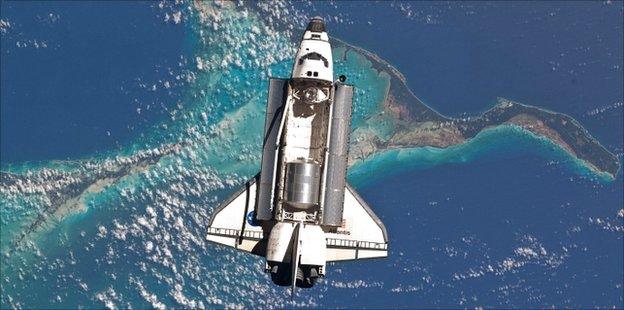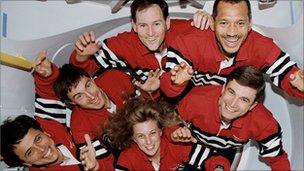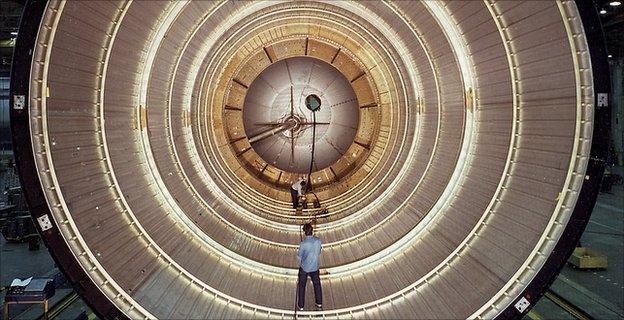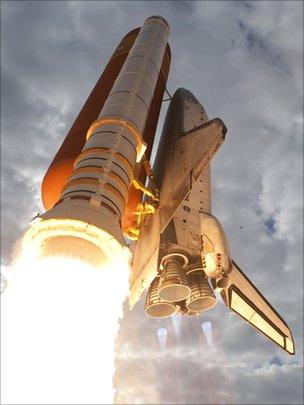Viewpoint: The space shuttle - 'magnificent flying machine'
- Published

The space shuttle vastly expanded the scope of human activity in space
As the icon for 30 years of human spaceflight conducted by the United States, the space shuttle symbolises impressive technical and social achievements.
The towering complete launch vehicle and the winged orbiter merely by their appearance suggest a rich technical legacy, but perhaps even more significant are the less visible social legacies of the world's first - and to date only - versatile, reusable spacecraft.
The space shuttle signaled a new era in space and markedly expanded the scope of human activity there.
The goal of the shuttle was to make spaceflight routine and economical for practical uses of space. As a delivery truck, service station, laboratory, habitat, and construction site, the shuttle made earth orbit a home and workplace.
Operating about 250 miles above earth on just a few circular paths, the shuttle nonetheless made it possible to annex nearby space as territory for human occupancy. Earth orbit is now a place where people live and work almost as naturally as on the ground.
Skylab and the Soviet Salyut and Mir space stations opened the way for orbital occupancy, but the shuttle's cargo capacity, flight frequency, and large crew complement made a continual, expanding human presence possible.
The International Space Station, assembled almost entirely via shuttle missions, culminated the effort to set up residence in orbit. Humanity is now in space to stay, if we so choose.
Strength in diversity
The shuttle also expanded the roles and diversity of people in space. Its varied missions called for engineers and scientists, not only pilots. Nasa created new astronaut roles - mission specialist and payload specialist.
These scientists and engineers had broad responsibilities during missions, handling most of the onboard work (except piloting the vehicle); they operated the robotic arm, carried out spacesuited extravehicular activities, conducted research, maintained spacecraft systems, and did any necessary repairs on the vehicle or its payloads.

The shuttle programme "democratised and internationalised" human spaceflight
Their tasks and skills ranged from muscling errant satellites into the payload bay to performing delicate surgery on electronics or lab specimens. The variety and complexity of astronaut tasks blossomed aboard the shuttle.
Recruiting for specialists tapped a much larger pool of qualified applicants than test pilots. The shuttle spacefaring corps included women, people of colour, medical doctors, PhD's in physical sciences and engineering, veterinarians, a few one-flight guests from other nations, and more than 30 European, Canadian, and Japanese astronauts.
With its typical crew of five to seven members and its average flight rate of five missions per year, the shuttle opened spaceflight to more people, and more diverse people.
Pushing the limits
The faces of a broader demographic sample of humanity in space captivated the public and inspired children with the possibility that "ordinary" people like themselves might someday make it into space.
And when these seemingly ordinary yet extraordinary people perished in the two shuttle tragedies, the worldwide public mourned them as if they were friends.
Inadvertently part of the shuttle legacy was to remind everyone that spaceflight was not really routine and, because of the inherent risk and danger, it might never be as routine as other modes of transportation.

The design and construction of the shuttle system pushed the limits of industrial processes
These aspects of the shuttle era make up a social legacy that may only now become appreciated: the space shuttle democratised and internationalised human spaceflight, and it advanced the ability of humans to migrate into space to stay.
The technical legacies of the space shuttle are also impressive in ways that many people outside the world of aerospace technology may never notice.
The shuttle pushed the limits of industrial processes, such as precision welding and high-pressure turbopumping. It required engineering innovation in its reusable propulsion and thermal protective systems.

The shuttle constantly evolved in order to stay in service, says Dr Neal
A hybrid rocket-spacecraft-glider, it solved complex avionics needs with innovative software. It pioneered the use of new materials, and it stayed abreast of critical technology advances through periodic upgrades.
The shuttle was a reusable vehicle that continually evolved and improved to stay in service for three decades, surviving the rigours of launch and reentry again and again. Astronauts respected it as "a magnificent flying machine" and engineers and technicians affectionately called each orbiter their "bird."
The space shuttle succeeded in its missions and did everything expected of it except reduce the cost of spaceflight. Despite its many successes, the shuttle always was a matter of choice, and it could have been abandoned at any time.
Its retirement now does not mean it is worn out or obsolete, only that it is no longer the chosen vehicle for spaceflight. Americans are famously notable for pursuing new technologies and new directions.
After 30 years in earth orbit, the present political decision is to turn local space transportation over to the commercial sector and refocus Nasa's spaceflight attention on exploration.
Nothing like the space shuttle has ever flown, and it may be that nothing like it ever will. That may be its ultimate legacy: the shuttle symbolizes an ambitious effort to make spaceflight as routine as airline travel. In many ways, it did.